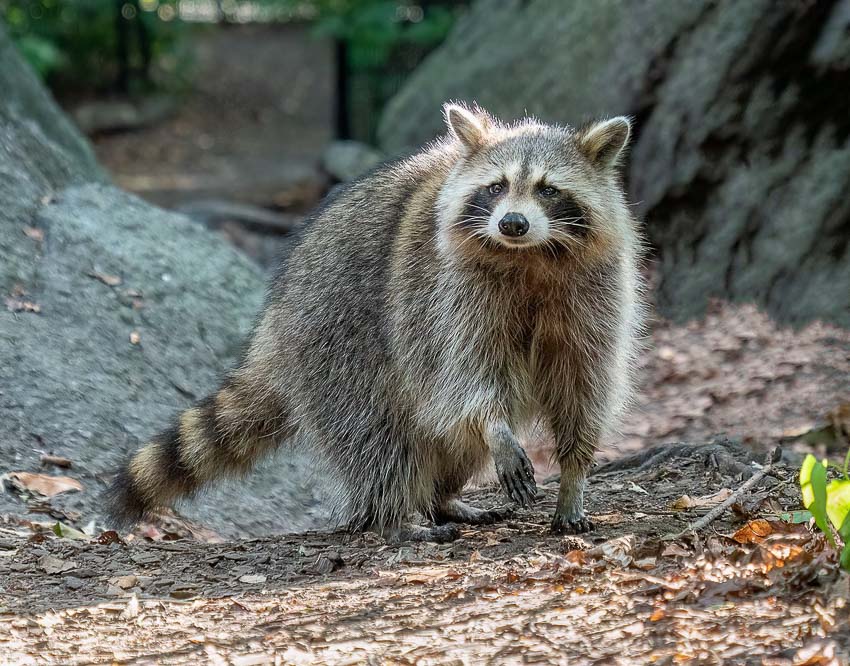Raccoons are friendly little bandits with bright eyes and mischievous grins. Unfortunately, they’re also dangerous pests that can damage your home, create messes in your yard, and pass diseases to you and your pets. This comprehensive guide shows you exactly how to get rid of raccoons and provides helpful prevention tips to keep them away.
Identifying a Raccoon Problem
Raccoons don’t casually visit your backyard. On the contrary, they move in and start causing chaos and mayhem. When they first arrive, you might find them fuzzy and adorable, but once they start living in the walls of your house and getting into your garbage, you’ll soon recognize them as a problem.
Signs You Have a Raccoon Infestation
It’s important to take steps to get rid of raccoons as soon as you see indications of an infestation. Pay attention to these signs:
- Trash spread around your yard
- Damage to your lawn, garden, and flower beds
- Scratches on trees
- Signs of scat
- The pitter-patter of feet in your attic
- Sounds in your walls
- Tracks
- Hisses, barks, chirps, and growls
Why You Should Get Rid of Raccoons
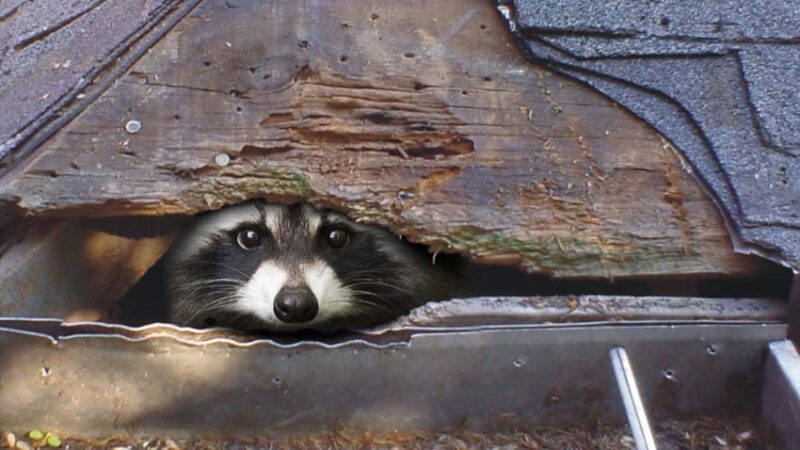
Raccoons damage homes and outbuildings by tearing shingles and siding, chewing through wires, and contaminating insulation in your attic.
In addition, they get into your garbage, destroy lawns and flower beds, and a foul odor accompanies their latrine site. Raccoons can also be aggressive toward people and pets.
The mayhem caused by raccoons is only overshadowed by their ability to spread disease. Their feces may contain roundworms which can be fatal to humans, and they carry other diseases like rabies and leptospirosis.
How to Get Rid of Raccoons in Specific Areas
Learn how to get rid of raccoons humanely when they invade your home and yard with these removal tips.
Raccoons in the Attic
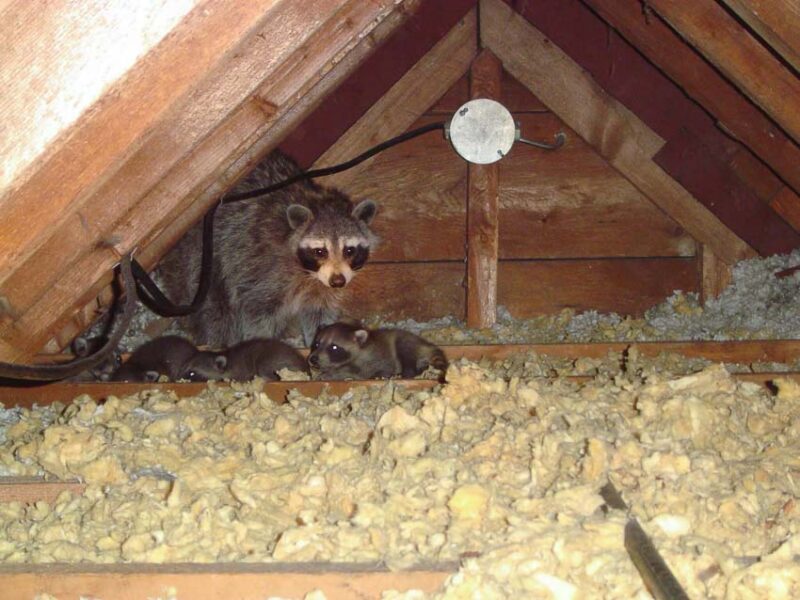
Attics are dry, warm, insulated, and high off the ground, making them the perfect place for a raccoon to raise a family. However, exclusion from your attic can be challenging because the raccoons see it as their home and won’t want to leave.
- Block all entry points except the main entrance, noticeable by the brown staining.
- Use a small amount of raccoon eviction fluid near the main entrance. Eviction fluid smells like a male raccoon and will encourage a female to move.
- Wait a few days before blocking off the main entrance, allowing female raccoons to relocate their babies.
- Use scrunched-up newspaper to block the main entrance, then wait a few more days. If the paper hasn’t been moved, the raccoons are gone, and you can permanently block all access points. Keep checking to ensure the raccoons don’t return.
How to Get Rid of Raccoons Under the House
Raccoons like to raise their young in high places, so it’s rare to find them with offspring in the crawl space, but if you do have one under the house, make sure it doesn’t have babies before you seal up all the exits. Scaring raccoons away is the best way to get them out from under your house.
Scare raccoons away by placing a bright light in the crawl space. Then, play loud music or talk shows to disrupt the raccoons and leave rags soaked with ammonia where they have been sleeping. Once they leave, secure the entry points.
How to Get Rid of Raccoons in the Yard
Like other types of wildlife, raccoons seek habitat, including food, shelter, and water. Take the following measures to get rid of raccoons in the yard:
- Secure your home and outbuildings
- Eliminate water sources
- Secure your trash
- Remove food sources, like pet food, fallen fruit, and bird feeders
- Protect your vegetable garden and compost pile with an electric fence
- Treat your lawn for grubs
Install motion-activated sprinklers and lights to scare raccoons from your yard. Repellents like ammonia and predator urine will also help keep raccoons away.
How to Get Rid of Raccoons in the Walls
If you have raccoons in your walls, there’s a good chance they are coming in through your attic. They can chew through drywall and other materials to get into your walls, and they are difficult to remove.
Many raccoon removal experts will cut holes in the wall and use a pole snare to extricate them from inside the wall, something which is best left to a professional.
Raccoons must leave the comfort of your walls to get food, so live trapping may be the best solution to get rid of raccoons in your walls. However, due to laws about Rabies Vector Species, the translocation of raccoons is not legal in all states.
Before you proceed, contact the wildlife department in your state for more information about humane raccoon removal.
How to Get Rid of Raccoons in the Chimney
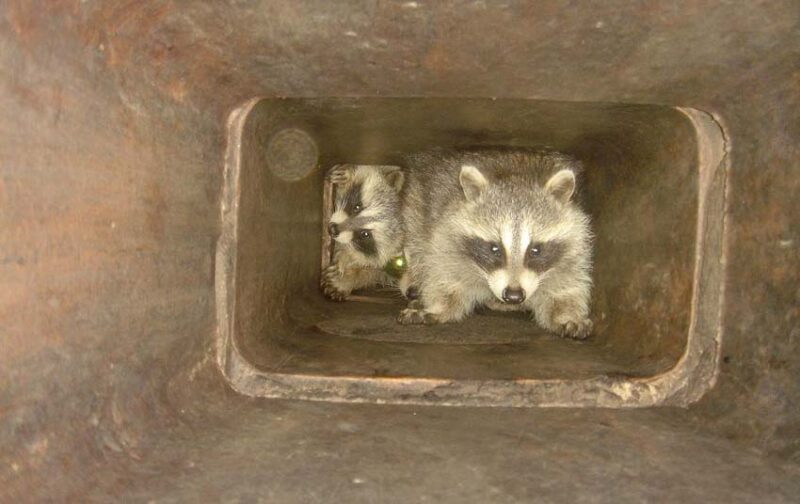
Raccoons begin mating in January, and their nesting habits may lead them to your chimney. They will seek out warm, dry nesting locations and are excellent climbers. In the wild, raccoons nest in hollow trees, and to an urban raccoon, your chimney resembles a hollow tree.
Since there is usually only one way for them to enter and exit your chimney, wait until you are sure the raccoon is in your chimney, then place a special chimney trap over the flue. If there are babies, you may need to hire a local raccoon removal expert to assist you.
Raccoons in a Tree
Raccoons take the high ground to protect themselves from predators, and they often use trees to access your roof. Unfortunately, they cause damage to tree trunks and branches and can destroy young trees by climbing on them.
Make DIY raccoon guards for trees from slippery materials like sheet metal to protect your trees from raccoons.
Keeping Raccoons Away from Your Home and Yard
Proofing your property to make your home less attractive and accessible to raccoons will help prevent an infestation and save you a lot of trouble.
Secure Trash Cans
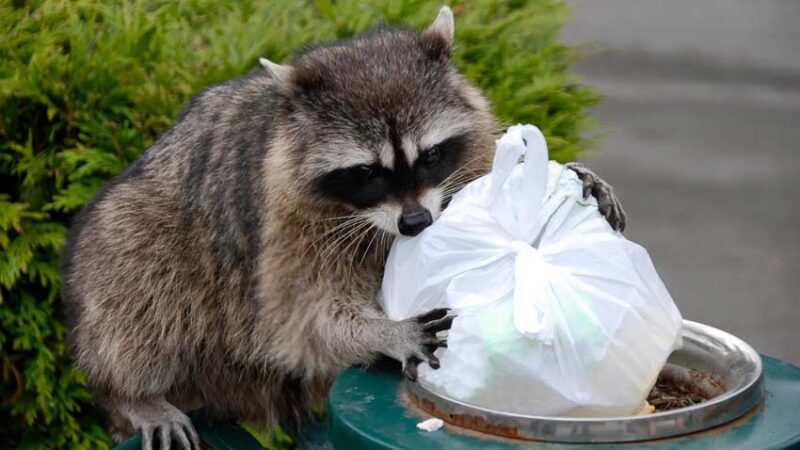
Trash is one of the main attractants for raccoons. If possible, keep your trash cans in a garage or outdoor shed. Otherwise, find a raccoon-proof trash can.
Remove Food Sources
Raccoons are omnivorous scavengers. Even though they are picky eaters, they eat a wide variety of foods, making it difficult to eliminate all potential food sources from your yard.
Instead, concentrate on eliminating or restricting access to major food sources like pet food, fallen fruit, bird feeders, grubs in your lawn, and garden vegetables.
Seal Entry Points
Proofing your home to deter raccoons can be challenging. Adult male raccoons can fit four to five inches in diameter through small holes, and females can squeeze into even smaller holes.
So when you’re looking for access points, be thorough. Remember that raccoons are agile climbers and incredibly resourceful.
Here are some common entry points used by raccoons:
- Soffit vents, accessed by downspouts or vines
- Roof and soffit intersections
- Damaged or loose attic vents, soffit, or fascia boards
- Weak spots in the roof and siding
- Chimneys
- Pet doors
- Roof vents
Even though it’s more common for raccoons to live in your attic than under your house, you should also do a complete inspection of the foundation. Also, check the exterior siding to ensure there aren’t any gaps large enough for a raccoon to get into your walls.
Install Motion-Activated Lights and Sprinklers
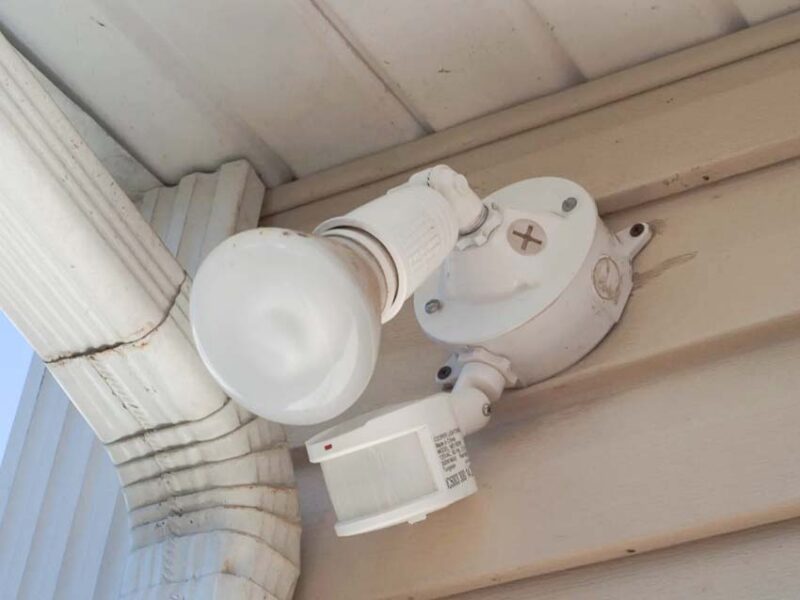
Since raccoons are nocturnal, motion-activated lights and sprinklers are effective deterrents. You can install standard motion-activated porch lights or use solar-powered flashing lights designed to repel raccoons. Motion-activated sprinklers near your trash cans are also effective.
Use Raccoon Repellents
Several types of raccoon repellents are available, including natural repellents that you can make at home. While repellents are not 100% effective on their own, they will help keep raccoons away when used in conjunction with other measures.
It’s important to note that ultrasonic devices have been proven ineffective against raccoons. Mothballs are also not recommended because they are bad for the environment and dangerous for pets and wildlife.
Use these products to repel raccoons:
- Raccoon eviction fluid
- Peppermint essential oil spray
- Coffee grounds
- Epsom salts
- Grated Irish Spring soap
- Crushed garlic
- Vinegar
- Ammonia
- Predator urine, especially coyote
Store-bought repellents are available as sprays or powdered products in shake canisters. Soak rags in household products like ammonia and vinegar and place them in areas infected by raccoons. Keep repellents fresh by reapplying them every few days.
Use a pump sprayer to disburse this homemade cayenne repellent wherever you see signs of raccoons:
- Bottle of hot sauce
- Bottle of ground cayenne pepper
- Gallon of water
Install a Fence
To keep raccoons away, install an electric fence. However, several types of fences can help—just not as much. Raccoons are strong climbers that can squeeze through small openings, so if you’re using wire, it needs to be 2-3” mesh or smaller.
Use a strand of electric fence at the top of your wire mesh fence for added protection.
Trim Trees and Bushes
Raccoons use trees and bushes to escape predators and access your roof. Use raccoon guards to keep them from climbing trees, and keep your trees and bushes trimmed with a battery-powered hedge trimmer or better, so they don’t create a bridge to your roof.
Keep Your Yard Clean
Prevention is the most humane way to avoid a raccoon infestation. Keep your yard clean by picking up fallen fruit and nuts, avoid hanging messy bird feeders, and don’t leave trash where raccoons can get into it.
Regularly Inspect Your Property
Set a weekly reminder on your phone to inspect your property to ensure that raccoons and other pests aren’t seeking shelter and causing damage to your house and outbuildings. It only takes a few minutes to walk around your yard to look for signs of raccoons, but it can be hard to remember without a reminder.
Seek Professional Help If Needed
Hiring a raccoon removal expert is much less expensive than it is to repair a roof or fix your soffit. Don’t hesitate to seek help from wildlife removal professionals if you can’t get rid of raccoons on your own.
Be aware that raccoon feces contain roundworms, which can be fatal to humans, so don’t attempt to clean up their latrines yourself.
Final Thoughts on Getting Rid of Raccoons Humanely
Like most people who have raccoons, you don’t want to hurt them, but you do want them gone. So as soon as you see signs of raccoons, take action before they become a major problem.
Learn how to deter raccoons from protecting your house and yard and keeping these mischievous bandits from making your home their own.
Be sure to check out our articles on how to get rid of ants and how to get rid of groundhogs!
Frequently Asked Questions About Raccoons
Are raccoons dangerous to humans and pets?
Raccoons can be very dangerous to humans and pets. While they don’t normally harm humans or large dogs, they will fight back if they are threatened.
In addition, if they are hungry enough, raccoons will prey on cats and kittens.
What diseases can raccoons carry?
Raccoons can carry dangerous viral and bacterial diseases like rabies and leptospirosis . They also transmit salmonella , E. coli , and roundworms .
What should I do if I find a raccoon nest with babies?
If you find a raccoon nest with babies, it’s best to call a wildlife rehabilitation expert for removal tips. You may be able to use the babies as live bait to trap the mother and relocate them.
How can I tell if a raccoon is rabid?
There are several signs that a raccoon is rabid.
Rabid raccoons will stagger, wander in circles, and may seem oblivious to loud noises. Their hair may be matted, and their faces will be wet from the discharge coming out of their mouth and eyes. They often emit repeated high-pitched squeals, growls, and hisses.
Do raccoons come out during the day?
Raccoons are mostly nocturnal, but it’s also normal for them to come out during daylight hours. They often come out to forage for food, especially if they know it will be available at a particular time.
Are there any plants that deter raccoons?
Raccoons dislike cucumbers and other squash, so you can plant them at your garden’s borders as an effective form of deterrence. They also do not like Oriental poppies, peppermint, Goji berries, garlic, globe thistle, and rose bushes.
Can I use a live trap to catch a raccoon?
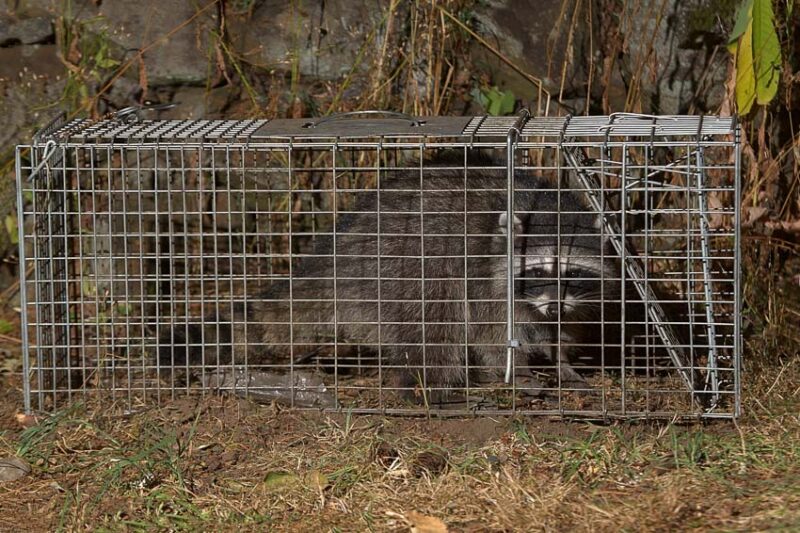
You can use live traps to get rid of raccoons. Try using various types of bait, like bacon, peanut butter, fresh vegetables, and canned cat food.
Before attempting to catch one, you should plan how to deal with them afterward. Adult raccoons range in size from 24-46 inches tall and weigh 12-25 pounds, and they can be very aggressive when threatened.
Also, relocating raccoons in many states is illegal, so check your local regulations before using a live trap.

